As always a feast for the eyes, unfortunately I couldn't be there in Augsburg to see the work in real life, but I'm sure we'll manage to meet up one day.
-

Win a Free Custom Engraved Brass Coin!!!
As a way to introduce our brass coins to the community, we will raffle off a free coin during the month of August. Follow link ABOVE for instructions for entering.
-

PRE-ORDER SHIPS IN SCALE TODAY!
The beloved Ships in Scale Magazine is back and charting a new course for 2026!
Discover new skills, new techniques, and new inspirations in every issue.
NOTE THAT OUR FIRST ISSUE WILL BE JAN/FEB 2026
You are using an out of date browser. It may not display this or other websites correctly.
You should upgrade or use an alternative browser.
You should upgrade or use an alternative browser.
La Créole 1827 by archjofo - Scale 1/48 - French corvette
- Joined
- Nov 10, 2019
- Messages
- 469
- Points
- 373

@Mirek
@Tobias
Thank you very much for your continued interest and kind words.
But thanks also to everyone else for the LIKES.
After some time, a short and unspectacular continuation of my building report:
Equipment of the mizzen royal yard - Vergue de cacatois de perruche
With the outfitting of the mizzen royal yard, the smallest yard of the corvette, this chapter - outfitting the yards - now comes to an end.
The mizzen royal yard of the model has a length of approx. 11.3 cm and a thickness of approx. 2 mm in the middle. The tye has a diameter of 0.25 mm. For the block slings I used ropes with a diameter of 0.25 mm, which were served. The results can be seen in the two pictures:
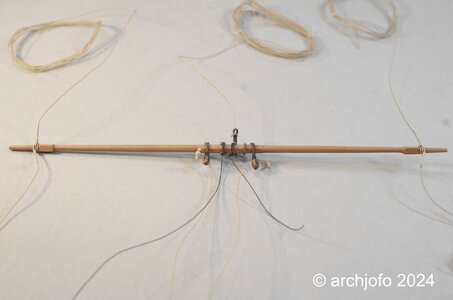
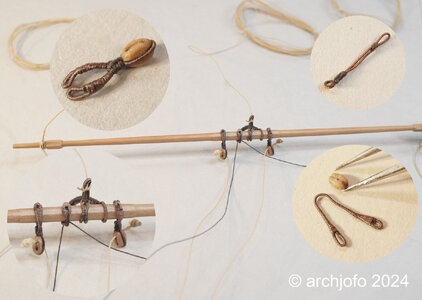
I am currently researching the equipment for the gaff rigging. There are still a lot of details to clarify.
See you soon ...
@Tobias
Thank you very much for your continued interest and kind words.
But thanks also to everyone else for the LIKES.
After some time, a short and unspectacular continuation of my building report:
Equipment of the mizzen royal yard - Vergue de cacatois de perruche
With the outfitting of the mizzen royal yard, the smallest yard of the corvette, this chapter - outfitting the yards - now comes to an end.
The mizzen royal yard of the model has a length of approx. 11.3 cm and a thickness of approx. 2 mm in the middle. The tye has a diameter of 0.25 mm. For the block slings I used ropes with a diameter of 0.25 mm, which were served. The results can be seen in the two pictures:


I am currently researching the equipment for the gaff rigging. There are still a lot of details to clarify.
See you soon ...
- Joined
- Nov 10, 2019
- Messages
- 469
- Points
- 373

@Mirek
Thank you for your motivating comment.
I would also like to say thank you for the LIKES.
Completion of the gaff with throat halyard - Corne avec drisse de mat
As already announced, I am currently working on the gaff rigging. To do this, it is necessary to add additional equipment to the gaff. I already made these some time ago. However, in addition to the metal block (signal haylard block) for the flag line on the gaff peak, a sheave for the sheet of the gaff topsail had to be installed, as can be seen in the following picture.
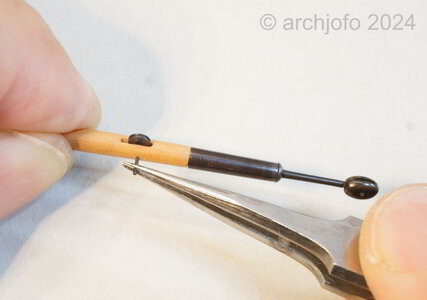
I also had to fit the jaw of the gaff with a heavy eyebolt.
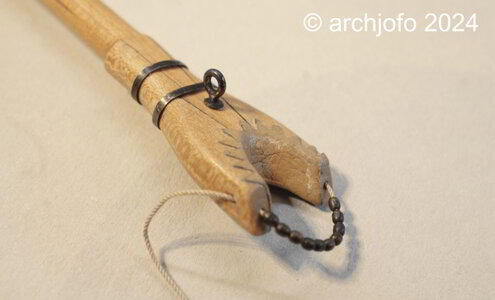
This eyebolt, which is under tension, was secured from below with a wedge.
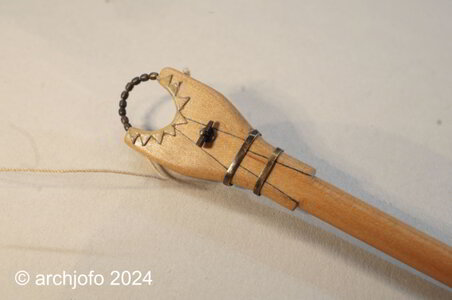
According to the information available to me (monograph, pictures of the Paris model), the throat halyard of the French corvette looked as follows:

The twin blocks required for the throad halyard have a length of 5.6 mm. As before, I use real disks for this size. I have also tried to reproduce the block axis as in the original.
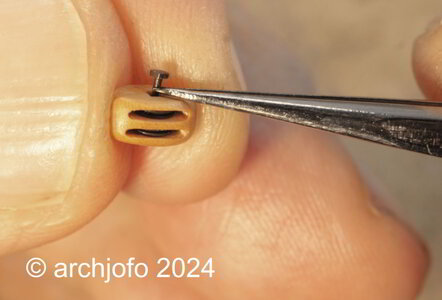
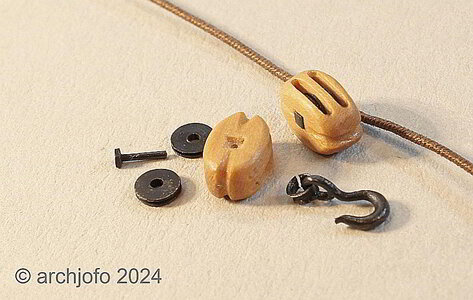
I will continue soon ...
Thank you for your motivating comment.
I would also like to say thank you for the LIKES.
Completion of the gaff with throat halyard - Corne avec drisse de mat
As already announced, I am currently working on the gaff rigging. To do this, it is necessary to add additional equipment to the gaff. I already made these some time ago. However, in addition to the metal block (signal haylard block) for the flag line on the gaff peak, a sheave for the sheet of the gaff topsail had to be installed, as can be seen in the following picture.

I also had to fit the jaw of the gaff with a heavy eyebolt.

This eyebolt, which is under tension, was secured from below with a wedge.

According to the information available to me (monograph, pictures of the Paris model), the throat halyard of the French corvette looked as follows:

The twin blocks required for the throad halyard have a length of 5.6 mm. As before, I use real disks for this size. I have also tried to reproduce the block axis as in the original.


I will continue soon ...
Kurt Konrath
Kurt Konrath
Outstanding work as usual.
Maybe I will learn to be this skillful one day in the future.
Maybe I will learn to be this skillful one day in the future.
Your work is just marvelous Johann. A true privilege to watch its careful progression.
Absolutely beautiful, Johann. I can only agree with the previous speakers and I am always amazed at how you manage to do this in 1:48 scale.
As always impressed for your eye for details, Johann. My respect.@Mirek
Thank you for your motivating comment.
I would also like to say thank you for the LIKES.
Completion of the gaff with throat halyard - Corne avec drisse de mat
As already announced, I am currently working on the gaff rigging. To do this, it is necessary to add additional equipment to the gaff. I already made these some time ago. However, in addition to the metal block (signal haylard block) for the flag line on the gaff peak, a sheave for the sheet of the gaff topsail had to be installed, as can be seen in the following picture.
View attachment 454653
I also had to fit the jaw of the gaff with a heavy eyebolt.
View attachment 454654
This eyebolt, which is under tension, was secured from below with a wedge.
View attachment 454655
According to the information available to me (monograph, pictures of the Paris model), the throat halyard of the French corvette looked as follows:
View attachment 454656
The twin blocks required for the throad halyard have a length of 5.6 mm. As before, I use real disks for this size. I have also tried to reproduce the block axis as in the original.
View attachment 454657
View attachment 454658
I will continue soon ...
Regards, Peter
- Joined
- Apr 20, 2020
- Messages
- 6,205
- Points
- 738

Dear Johann@Mirek
Thank you for your motivating comment.
I would also like to say thank you for the LIKES.
Completion of the gaff with throat halyard - Corne avec drisse de mat
As already announced, I am currently working on the gaff rigging. To do this, it is necessary to add additional equipment to the gaff. I already made these some time ago. However, in addition to the metal block (signal haylard block) for the flag line on the gaff peak, a sheave for the sheet of the gaff topsail had to be installed, as can be seen in the following picture.
View attachment 454653
I also had to fit the jaw of the gaff with a heavy eyebolt.
View attachment 454654
This eyebolt, which is under tension, was secured from below with a wedge.
View attachment 454655
According to the information available to me (monograph, pictures of the Paris model), the throat halyard of the French corvette looked as follows:
View attachment 454656
The twin blocks required for the throad halyard have a length of 5.6 mm. As before, I use real disks for this size. I have also tried to reproduce the block axis as in the original.
View attachment 454657
View attachment 454658
I will continue soon ...
you are doing outstanding work!!!
When I see your beautiful work products, I tell myself this is the horizon I want to reach in our hobby.
Your ability to combine uncompromising precision and the most beautiful workmanship that I have seen , make you a master artist and your products art of the highest order
- Joined
- Nov 10, 2019
- Messages
- 469
- Points
- 373

@Kurt Konrath
@Mirek
@dockattner
@Steef66
@Peter Voogt
@shota70
Thank you for your interest and everyone else for the LIKEs.
Continuation: throat halyard – Drisse de mat
We continued with the manufacture of the block strops for the throat halyard. The hook was tied into the lower double block with a thimble. The halyard with a diameter of 0.46 mm (ø 2 mm in the original) was attached to the block strop of the upper block using an eye splice.
I then quickly attached the gaff to the finished throat halyard, as can be seen in the following pictures.
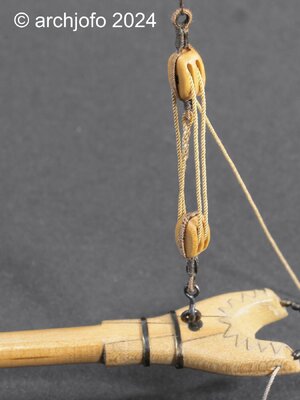
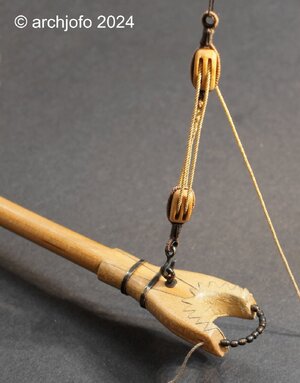
To be continued...
@Mirek
@dockattner
@Steef66
@Peter Voogt
@shota70
Thank you for your interest and everyone else for the LIKEs.
Continuation: throat halyard – Drisse de mat
We continued with the manufacture of the block strops for the throat halyard. The hook was tied into the lower double block with a thimble. The halyard with a diameter of 0.46 mm (ø 2 mm in the original) was attached to the block strop of the upper block using an eye splice.
I then quickly attached the gaff to the finished throat halyard, as can be seen in the following pictures.


To be continued...
Ganz großes Kino. Unique top, great, simply indescribable.
i would not know anything which could be made better - 100% perfect workGanz großes Kino.
- Joined
- Nov 10, 2019
- Messages
- 469
- Points
- 373

@pianoforte
@Mirek
@Uwek
Thank you very much for your interest and the nice comments.
Also many thanks to all for the LIKES.
Continuation: Peak halyard - Drisse de pic
The peak halyard of the French corvette led over a double block with iron fittings and was probably hooked to an eyebolt on the cap des mizzen mast, similar to a depiction in the Atlas du Génie Maritime.
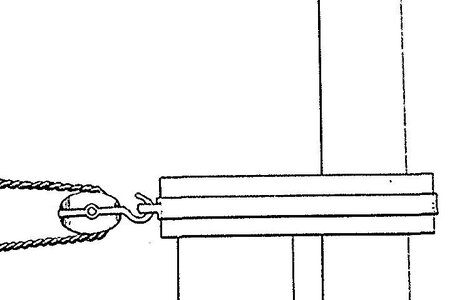
Source: Atlas du Génie Maritime - detail
I made the double block with a length of approx. 4 mm in the usual method from service tree. The fittings were made in the manner already described from partially prefabricated etched and cast brass parts. The hard soldering of the hook is a tricky job, but I've managed it in the meantime with some practice. The biggest problem is destroying the part with too much heat from the torch.
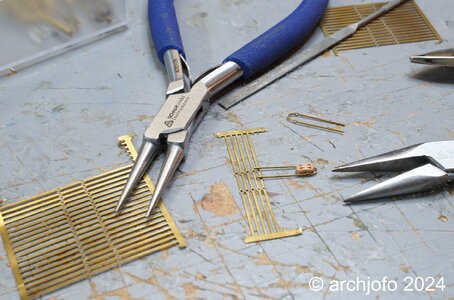
After adjusting the fitting to the block and soldering in the hook, the solder joint was sanded clean.

The next two pictures show the finished double block with the eyebolt, which will later be attached to the cap.
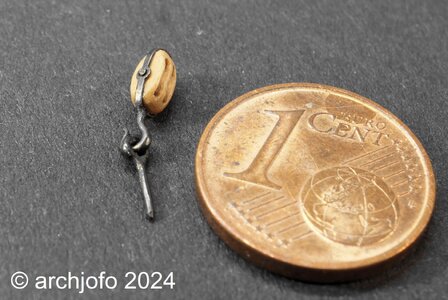
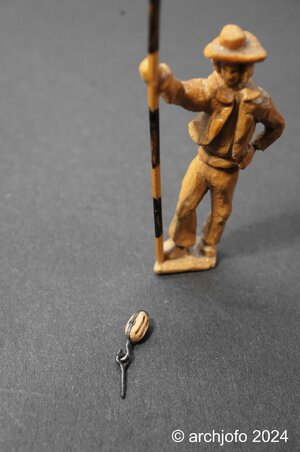
And last but not least, a picture of the hooked double block.
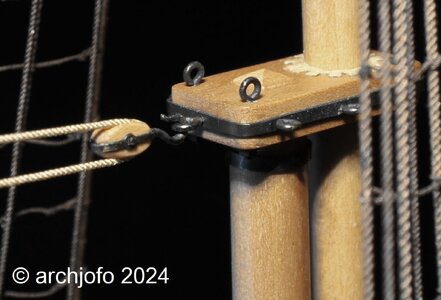
Now there are still a number of different blocks to be made for the gaff and the boom.
To be continued ...
@Mirek
@Uwek
Thank you very much for your interest and the nice comments.
Also many thanks to all for the LIKES.
Continuation: Peak halyard - Drisse de pic
The peak halyard of the French corvette led over a double block with iron fittings and was probably hooked to an eyebolt on the cap des mizzen mast, similar to a depiction in the Atlas du Génie Maritime.

Source: Atlas du Génie Maritime - detail
I made the double block with a length of approx. 4 mm in the usual method from service tree. The fittings were made in the manner already described from partially prefabricated etched and cast brass parts. The hard soldering of the hook is a tricky job, but I've managed it in the meantime with some practice. The biggest problem is destroying the part with too much heat from the torch.

After adjusting the fitting to the block and soldering in the hook, the solder joint was sanded clean.

The next two pictures show the finished double block with the eyebolt, which will later be attached to the cap.


And last but not least, a picture of the hooked double block.

Now there are still a number of different blocks to be made for the gaff and the boom.
To be continued ...
Super nice workmanship, your brass work is absolutely finely executed, I still have a lot to learn to reach your quality. Practice makes perfect.
I agree with Tobias. I am always impressed with the full range of your work - but your metalwork is at another level altogether. How you manage redundant soldering without melting previously soldered parts or melting the base metal is beyond me. I have played around with different temperature solders, but success always seems just beyond my reach.
Great work - are these hooks from the merket or selfmade?



